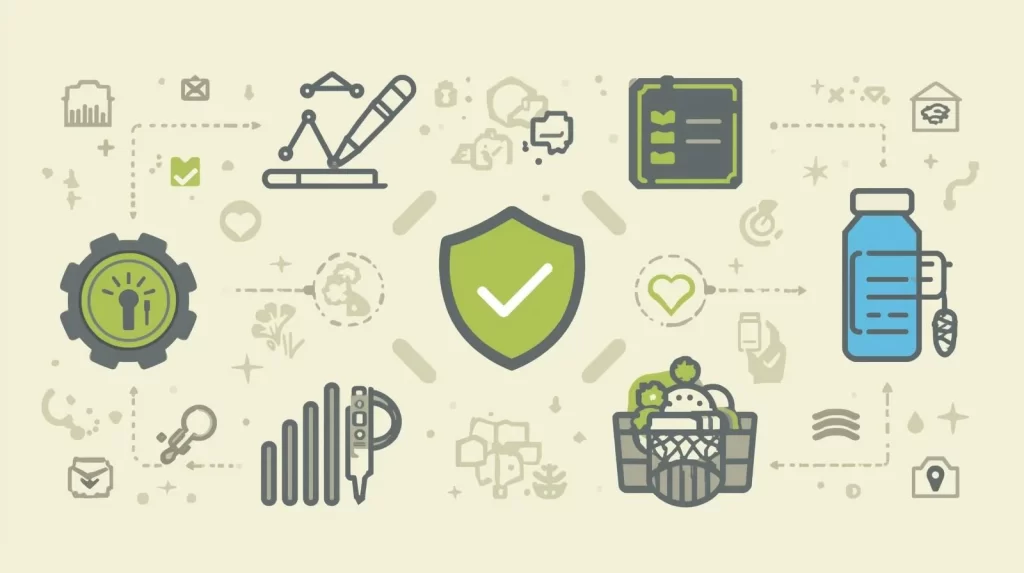Accreditation is no longer just a planned audit; it is now an ongoing, data-driven responsibility.
The change is happening because spreadsheets can’t handle the increased complexity, regulatory expectations, and evidentiary requirements. This is why modern accreditation strategy now puts accreditation software at the core.
Before, accreditation teams worked in cycles: audit season, documentation season, panic season, and then nothing for months.
However, it is now observable that standards change more rapidly. Inspectors want to be able to track things in real-time, and boards want real-time indicators, instead of yearly binders.
This era is the new age: accreditation is now a quality discipline that is always on, not just a once-a-year compliance exercise.
In the age of artificial intelligence, accreditation is becoming increasingly proactive through the use of automated evidence mapping, predictive analytics, and real-time dashboards.
This article will dive into what that shift really means: the capabilities to watch, the features that matter, and the mindset changes teams need to make now.
It’s time to move from “audit season mode” to continuous quality mode, and the organizations that pivot early will have the advantage.
What is the New Era of Accreditation, and Why Does it Matter Now?
It’s undeniable that in this fast-paced era, the traditional tools we once used, such as spreadsheets and a drive, can no longer keep up. For industries such as higher education and healthcare, they demand more from technology than ever before.
This is why companies are switching to software designed specifically for accreditation.
These days, rules continue to change, and the government expects clear proof. With more paperwork, more reviewers, and tighter deadlines, handling files manually is no longer a practical option.
A modern accreditation management system puts all the evidence, tasks, and approvals in one place. This reduces redundancy and prevents files from becoming misplaced. Furthermore, it ensures that evidence is always linked to the correct standard of care.
What Strategic Benefits Does Next-Gen Accreditation Software Deliver?
Through the use of next-generation accreditation software, manual workload and administrative overhead are streamlined through intelligent automation. Take a look at these benefits:
A. Increased Efficiency
The biggest increase in efficiency comes from the huge drop in personnel hours. An accreditation management solution automates the mapping of evidence and the assigning of tasks.
In this manner, nurses, professors, and directors who have a substantial workload don’t have to waste time on screen uploading data, as the system does it automatically.
Instead of sending reminder emails, the technology initiates tasks intuitively. The technology will immediately start the tasks instead of sending reminder emails.
This enables clinical, academic, and leadership staff to focus on patient care, education, and decision-making, rather than on paperwork.
Automation cuts down on work. Less clicking, less uploading, and less chasing.
B. Enhanced Visibility and Continuous Readiness
Before, accreditation teams only found out their status a few weeks before an audit. The staff hurried to gather files, verify policies, and hope that nothing was missing. It was lots of stress, quick reactions, and guesswork.
The new approach differs significantly. Modern accreditation management software features real-time dashboards that provide a clear view of your current status at all times.
You can view and track all your standards, documents, and tasks. Teams can address gaps immediately, rather than realizing them at the last minute.
Being able to catch things before they snowball gives you ample time to resolve them. Leaders don’t have to ask themselves, “Are we compliant right now?” Such visibility makes everyone in the department feel safe and confident.
When data is always up to date, accreditation stops being a deadline and becomes part of everyday work.
C. Streamlined Compliance Workflows and Governance
More than just being a modern accreditation software, it helps organizations stay compliant with government-mandated rules.
For example, when the system identifies a gap, it can automatically assign corrective actions, schedule policy reviews, and maintain a complete, time-stamped record of all that took place.
Hence, your team doesn’t have to chase people for updates or seek approvals. Every step, from finding a compliance issue to resolving it, is captured in one clear, seamless flow.
Additionally, managers can track what’s happening in real-time. Auditors can monitor who did what and when. Evidently, everyone stays aligned without the manual tracking, follow-ups, or confusion.
This illustrates that when you automate daily menial tasks, you are guaranteed an output that, following the rules, seems like it’s second nature, and reduces the likelihood of mistakes.
D. Improved Data-Driven Quality Management
With modern platforms, compliance data becomes more than paperwork; it becomes something you can actually use to improve quality.
Currently, systems can identify gaps, highlight patterns, and suggest areas for improvement by tracking standards, policies, tasks, and proof of compliance in real-time.
For example, hospitals can link audit findings to patient safety programs. Schools can ensure that how they assess student learning is aligned with how they measure the performance of their institution itself.
With an improved accreditation software, leaders don’t just sit around and cram preparations nearing an audit. They now utilize the data they already have to enhance quality, resolve issues more efficiently, and remain prepared at all times.
What are the Major Innovations and Challenges Shaping Accreditation by 2026?
The accreditation landscape is evolving and developing. By 2026, most institutions will be embracing:
A. AI and Automated Evidence Mapping
AI is transforming the way accreditation operates, particularly in terms of linking requirements, documents, and evidence.
Previously, you might have had to manually review piles of policies and files to ensure they align with the correct standards. Aside from the fact that it could be gruesome work, this task alone could consume time that could have been spent on something else.
Now, with AI and automated evidence mapping, the entire document can be scanned, tagged automatically, and even draft compliance write-ups in just a matter of seconds.
As a result, the review process becomes significantly faster. Teams no longer struggle with monotonous, repetitive administrative tasks.
Instead, they can actually focus on what the data means, making decisions, improving performance, and driving better outcomes. Accuracy also improves because the system is less likely to miss evidence or misinterpret it.
B. Predictive Analytics and Risk Forecasting
Next-generation accrediting platforms now utilize a “Compliance Risk Score,” similar in concept to the Joint Commission’s SAFER Matrix, which stratifies risk to predict which standards are most likely to fail in the near future.
The algorithm looks at real evidence trends, such as missed deadlines, policies that are about to expire, unresolved findings, and incident reports. It then predicts which standards are getting weaker.
| Data Signal Tracked | Meaning of the System | Impact on Risk Score |
| Policy dates that are about to run out | Key papers that are about to be changed or run out | Risk score goes up/increases |
| Multiple open corrective actions | Problems not fixed on time | Risk score spikes |
| Many safety and clinical problems | Quality drift found | A higher probability of noncompliance |
| Low evidence attachment per the standard | Missing paperwork | Red signal for the standard |
Using the Compliance Risk Score, businesses can prioritize their resources and focus on the most critical areas for improvement.
Instead of waiting for an audit to identify problems, teams can take proactive action to address them, assign tasks to resolve them, and monitor progress in real-time to see how things are improving.
This predictive method makes compliance a planned procedure instead of a reactive effort.
C. Integration and Data Migration Costs
One of the most challenging aspects of implementing a new accreditation management system is integrating it with existing systems, such as HRIS, LMS, and EMR.
The organization requires API mapping, custom connectors, and field-to-field data alignment, as these older systems were not designed to integrate with modern accrediting platforms.
Moving and cleaning up data is another expense in itself and requires a significant amount of time and extensive labor.
Most businesses have years’ worth of files saved in different versions, formats, and naming systems that don’t always match.
Data needs to be cleaned, organized, validated, and standardized before it can be migrated. If this step is skipped, the new system will inherit old errors and may even exacerbate them.
D. Change Management and User Adoption
The best software doesn’t work if people don’t use it.
The best accreditation management software requires user adoption to work.
This means that for the system to function effectively, teams must use it every day, becoming familiar with it, because proper training is essential.
Leadership support is just as important; without it, people may revert to old habits like using spreadsheets and shared files.
Adoption works best when the software helps the end user, not just administrators. It should make their work easier, faster, and less stressful.
Which Industries Benefit Most from This Technological Shift?
Different industries perceive this shift differently, but some feel it more acutely than others.
Here are some industries that will benefit the most from this technological shift:
A. Healthcare: Continuous Readiness and Patient Safety
One of the major industries that benefits from accreditation innovation is the healthcare industry. It fast-tracks reporting systems and operations in general, making real clinical results and continuity of operations.
These are the following healthcare accrediting bodies:
- The Joint Commission (TJC)
The Joint Commission is a global leader in driving quality improvement and patient safety in healthcare, accrediting U.S. healthcare organizations and programs.
For some, TJC standards can be challenging to comprehend, as they are based on extensive evidence and research.
With current healthcare accrediting software, you can quickly connect any clinical incident, such as a prescription error, a patient fall, or a near-miss, to the corresponding TJC standard.
This helps organizations check their compliance and readiness ahead of time, reducing last-minute stress and keeping patients safer.
- National Committee for Quality Assurance (NCQA)
The NCQA, on the other hand, measures and accredits health plans. One of the bottlenecks in their processes is the extensive information required.
However, with the right assessment and accreditation management system, you won’t have to export quality metrics to a spreadsheet by hand.
Moreover, it can immediately pull them from reporting systems, allowing employees to spend less time on administrative tasks and more time with the data.
- Centers for Medicare & Medicaid Services (CMS)
CMS is an agency that offers health coverage to millions of U.S. citizens. An integrated accreditation management software enables real-time monitoring of all requirements for both clients and employees.
This way, changes can be made on time without needing to use citations. Teams can always verify that they are still on track, which reduces the risk of fines and ensures that reports are submitted on time.
- Connecting Incidents to Outcomes
The disparity between the approval process timeframe and the moment the care services are performed is one of the evident changes from this innovative mechanism. During an audit, corrective action is always connected to the findings.
When an incident occurs, the system analyzes root causes to prevent future issues, improves processes to reduce risk, and allows the team to implement long-term solutions rather than just quick fixes.
By linking events to their causes and effects, organizations can move from a reactive to a proactive risk management approach, ultimately improving overall performance and morale.
B. Higher Education: Programmatic and Institutional Review
Obtaining accreditation in higher education can be a daunting task.
Colleges must deal with both institutional accreditation (such as HLC and SACSCOC) and program-specific accreditation (like ABET and AACSB), each with its own requirements, formats, and paperwork.
Each accrediting body asks for different types of evidence, documentation, and processes.
A modern accreditation management system brings everything together in one place: evidence, policies, committee feedback, and required files, so you’re not scrambling across different folders and platforms.
Having a trusted system makes everything smoother, less cluttered, and less confusing, making it way easier to keep track of.
Moreover, it takes the stress out of curriculum mapping. Instead of manually checking every file, the system automatically connects syllabi, rubrics, student work, and even exam questions to the specific standards they need to meet.
Schools can easily demonstrate how each course supports Student Learning Outcomes (SLOs) without having to dig through scattered folders or juggle multiple spreadsheets.
Reporting, alignment, and compliance become clearer, not another headache. This helps reduce duplication, clears up any confusion about versions, and makes review cycles faster and more organized.
C. Certification and Credentialing Bodies
During your organization’s certification process, it is important to note that having the aid of a trusted accreditation management system makes every step consolidated. Let us walk through the entire lifecycle of the certification process step by step.
First, when it comes to candidate management, it sets clear guidelines for eligibility, data handling, and data fairness and accessibility. More importantly, it also upholds ethical standards in scheduling and support.
In exam development, accreditation systems ensure that they are developed through validated methodologies. These come in the form of job task analysis, blueprinting, and psychometric testing. It mandates the involvement of qualified subject matter experts.
When it comes to performance-based certifications, assessors play a vital role. With accreditation systems requiring rigorous assessor selection, the correct ethical conduct
During performance-based certifications, assessors play an important role. Accreditation safeguards the integrity and minimizes biases by providing standard training, calibration, and ethical conduct.
Accreditation systems also support the issuance of digital badges. It ensures that validated outcomes are linked to badges and are issued through trusted platforms.
What Does the Future Roadmap for Accreditation Software Look Like?
Accreditation software should evolve with the times, becoming better, faster, and easier to use by following suit. A system that saves data is no longer all that companies want.
Here’s what accreditations look like in the coming years:
A. Emerging Trends and Full-Scale Interoperability
By 2026, accreditation management system software with open APIs will be able to connect seamlessly with virtually any other system.
It’s exciting to see that all your compliance, quality, and performance information will now be in one place. It’s straightforward to review records, examine policies, and determine the next steps.
This new approach will expedite an organization’s decision-making, reduce the frequency of errors, and streamline the whole accreditation process.
- Connecting with HRIS
When you integrate your team’s Human Resource Information System, it will automatically track employee credentials, training completions, and role assignments.
This step ensures seamless management of key employee details, keeping personnel information up to date, reducing strenuous manual data entry, and ensuring staff qualifications are readily available.
- Linking with LMS
Connecting with LMS systems ensures that accreditation dashboards remain up to date, displaying student progress, completed courses, and the curriculum structure.
Linking with LMS makes it efficient and easy to track learning outcomes and use the data to make improvements. Program and institutional reviews become much simpler, faster, and more accurate.
- Bringing Finances Together
An integration of your financial and accreditation systems can efficiently monitor budgets, funding, and track the accurate allocation of resources for certification activities.
This tool is catalytic in connecting, planning, and resource management for the organization. It makes it easier for leaders to check and balance, in alignment with their long-term goals.
B. Potential Next-Gen Challenges (Security and Ethics)
As accreditation management systems become more advanced, the risks surrounding security and ethics also increase.
To protect sensitive information, such as compliance records, candidate files, and institutional documents, strong cybersecurity measures are essential, which include encryption, strict access controls, and thorough audit logs.
AI-powered features, particularly in areas such as innovation management certification, introduce an additional layer of ethical complexity that organizations must handle with care. These systems can affect fairness, transparency, and accountability in decision-making.
Systems that generate compliance narratives or recommend fixes must be precise and dependable to avoid misleading auditors.
For trust and integrity to truly work, institutions need clear guidelines on how to utilize AI, monitor it, and ensure that individuals are held accountable.
Excellent accreditation software can still pose a risk if safety controls are not in place. Planning, training the team, and monitoring are crucial to ensure that the technology enhances compliance and quality safely.
C. Advancements in Automated Self-Study and Audit Simulation
Next-gen accreditation systems make self-study and audits much easier through full automation.
Envision a system that provides a comprehensive mock audit report, com,ining risk forecasts, evidence tracking, and task progress within the organization.
What sets it apart is that it can predict potential outcomes, helping teams determine priorities and highlight these issues prior to the audit.
Accreditation management software is all about staying one step ahead; instead of scrambling to fix problems, it helps organizations prepare for and stay compliant with regulations.
With real-time updates and automation, audits become significantly easier, enabling teams to focus on improvement rather than being overwhelmed by paperwork.
Conclusion
Next-generation certification tools and accreditation management systems transform organizations’ compliance. This way, businesses and organizations can keenly focus on quality, mitigate risks, and work more efficiently.
Future accreditation will undoubtedly rely on data. Continuing to lead the way on modern platforms means staying up-to-date with the latest standards, being prepared for anything, and directly linking compliance to actual outcomes.
Don’t wait to upgrade your routines. Advanced accreditation tools simplify your job, increase your business’s visibility, and ensure everything is above board.
Give them a try and see the difference!
Frequently Asked Questions (FAQs)
1. What is software for managing accreditation?
Accreditation management software functions as a digital compliance assistant. It consolidates all your proof, tasks, deadlines, and reports in one place, eliminating the need for teams to manage spreadsheets, shared files, or disorganized paperwork.
2. What is the most crucial aspect of an accreditation management system?
The best thing about it is that it saves time and makes things work better. A modern accreditation management system automates repetitive operations, displays compliance status in real-time, and identifies gaps before they become issues.
3. What sets accreditation software apart from certification software?
Accreditation software enables businesses to meet external requirements, maintain compliance, and prepare for audits. In contrast, certification software, however, are registering candidates, scheduling exams, managing assessors, and issuing digital credentials or badges.
4. What is a system for managing assessments and accreditations?
An assessment and accreditation management system is a single platform that manages all aspects of the accreditation process.
Everything is consolidated, from conducting self-assessments and gathering data to tracking remedial actions and being prepared for audits, as well as driving ongoing improvement.
5. What is the point of getting quality management accreditation?
Obtaining quality management accreditation means that your business not only meets the requirements but also continually improves its performance.
It transforms compliance from a list of tasks to a culture of excellence that continually seeks ways to improve. It makes audits run more smoothly, reduces mistakes, and helps your firm gain confidence and credibility with stakeholders.
6. What features should I look for in software that helps with healthcare accreditation?
The best healthcare accrediting software integrates with your EHRs, incident reporting systems, and other clinical systems.
Look for automation tools that can handle processes and deadlines, real-time dashboards that provide you with rapid information, and the ability to track standards from TJC, NCQA, or CMS easily.
7. What does it mean to have an accreditation management solution?
Your full-service platform for all compliance operations is an accreditation management system. It tracks evidence, automates procedures, organizes remedial actions, and provides you with valuable information.






